Top Pick for
Premium Power Station
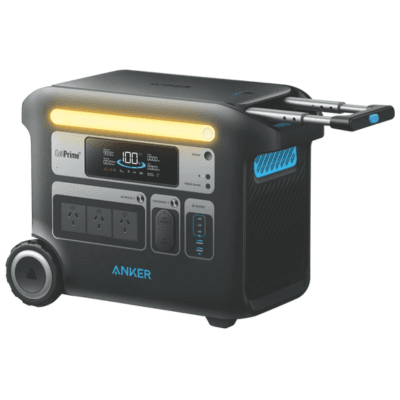
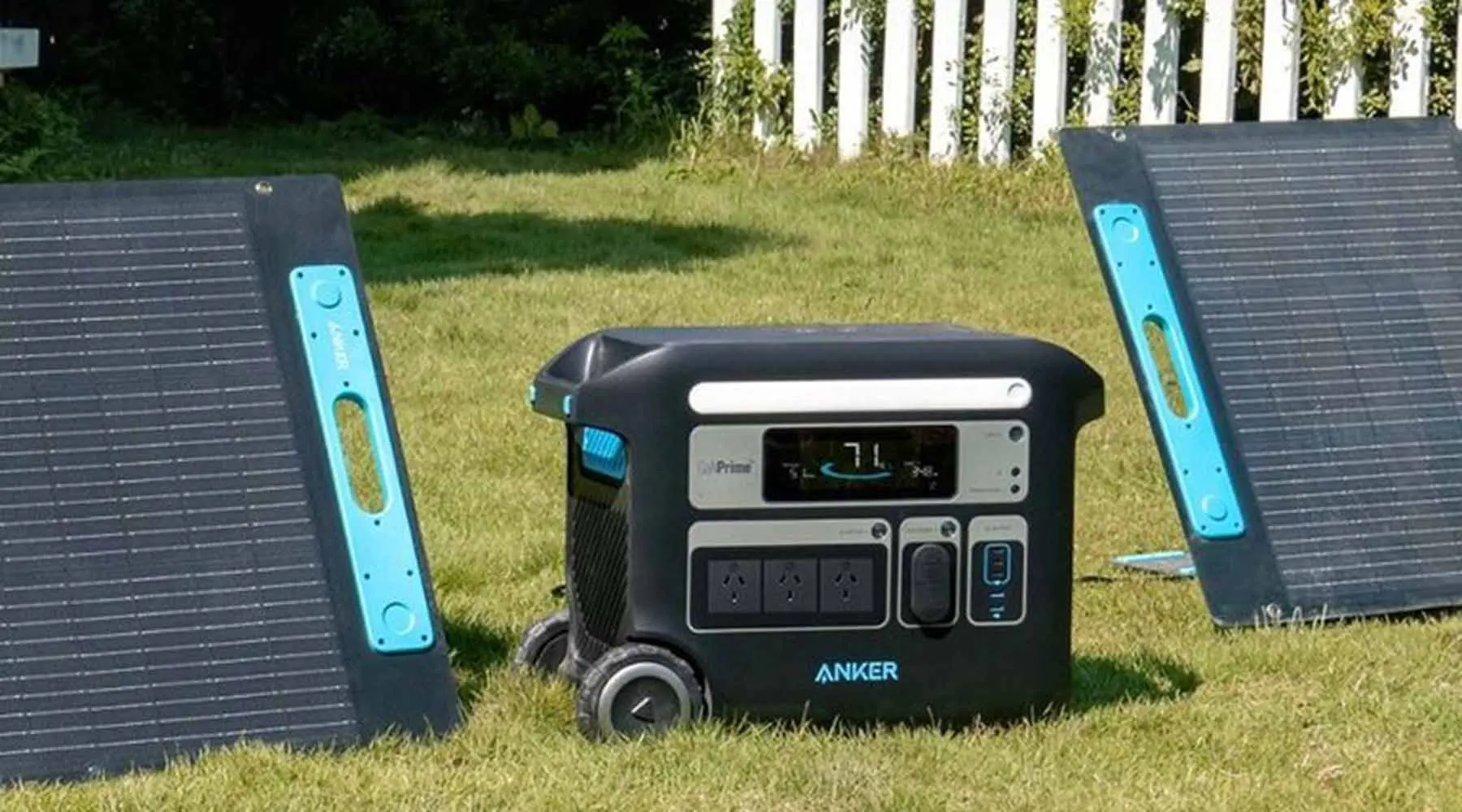
Top Pick for
Premium Power Station

Top Pick for
Budget power station
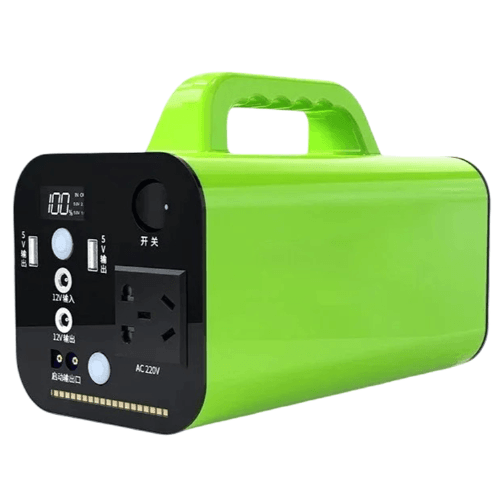
Top Pick for
Camping power station
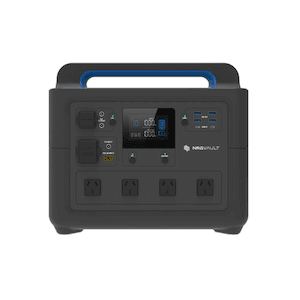
Top Pick for
Battery box
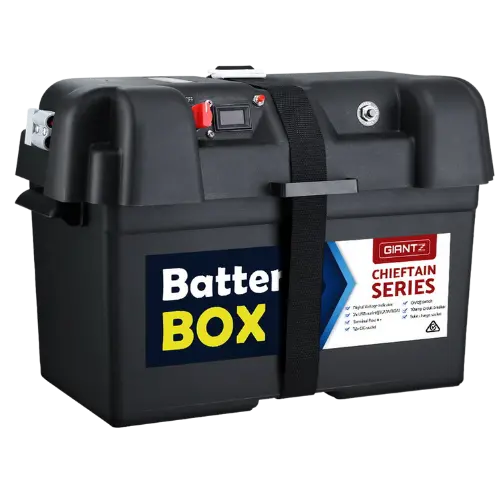
There's nothing better than getting out of the big smoke and into nature, but we can't always be completely without electricity for long periods of time. Be it phones, portable fridges, cameras, LED lights or even your sound system, there are plenty of reasons why you need to plug in – even in remote areas.
Thankfully there is an option for campers, workers and outdoor lovers who want to be well off the beaten track, but not without home comforts. They're called power stations. These power stations can be charged through a mains connection at home before you leave on your trip, via your car battery on the way or through portable solar panels in situ.
I've been using them for years, and have been sent power stations from many manufacturers to test and experience in that time. What is the best power station in Australia? Well, it depends on your needs. Below, you'll find a breakdown of the power stations I think you should be considering and why.
I have personally experienced or owned almost all of the power stations in this list, comparing them during my outdoor adventures. In addition to my impressions, I’ve also looked at the average customer ratings at established ecommerce sites like Amazon and eBay (as of the end of 2023), user reviews on sale portals like Snowys, Anaconda, Tentworld and BCF, and the opinions of other professional reviewers and tradies.
Read more detail on our methodology below.

What defines a budget power station? In this writer's opinion, a budget power station is under $500. But you also don't want to skimp on the cell chemistry. Go too low end, and you'll end up with a potential fire hazard.
At $502, the Kogan 500W-C Portable Power Station comes in just over this price threshold, but it uses the safer LiFePO4 battery type that is the safest on the market. Plus, it still ticks a lot of boxes.
It's a very portable power station at 3.85kg. It has a relatively small footprint (240×120×130mm) with an easy carry handle making it ideal for camping. With a 500W AC output, it's perfect for small appliances and electronics, but you're going to need to look elsewhere for bigger appliances. With that said, its 80000mAh lithium battery still gives you plenty of legs.
In terms of connectivity, you'll find 2 AC outlets, 3x USB-A, 1x USB-C PD (60W), 1x DC port and a 12V socket for car jumps, which is impressive for this sized device.
It is able to operates in extreme temperatures from -20C all the way to 60C. An LCD display and built-in LED light with SOS emergency function are welcomed bonuses, too.
At this price, the Kogan 500W-C Portable Power Station ticks pretty much every box you could hope for. Although we will say, it has a disappointingly long charge time. The lime-green plastic finish is also a bit of an acquired taste.
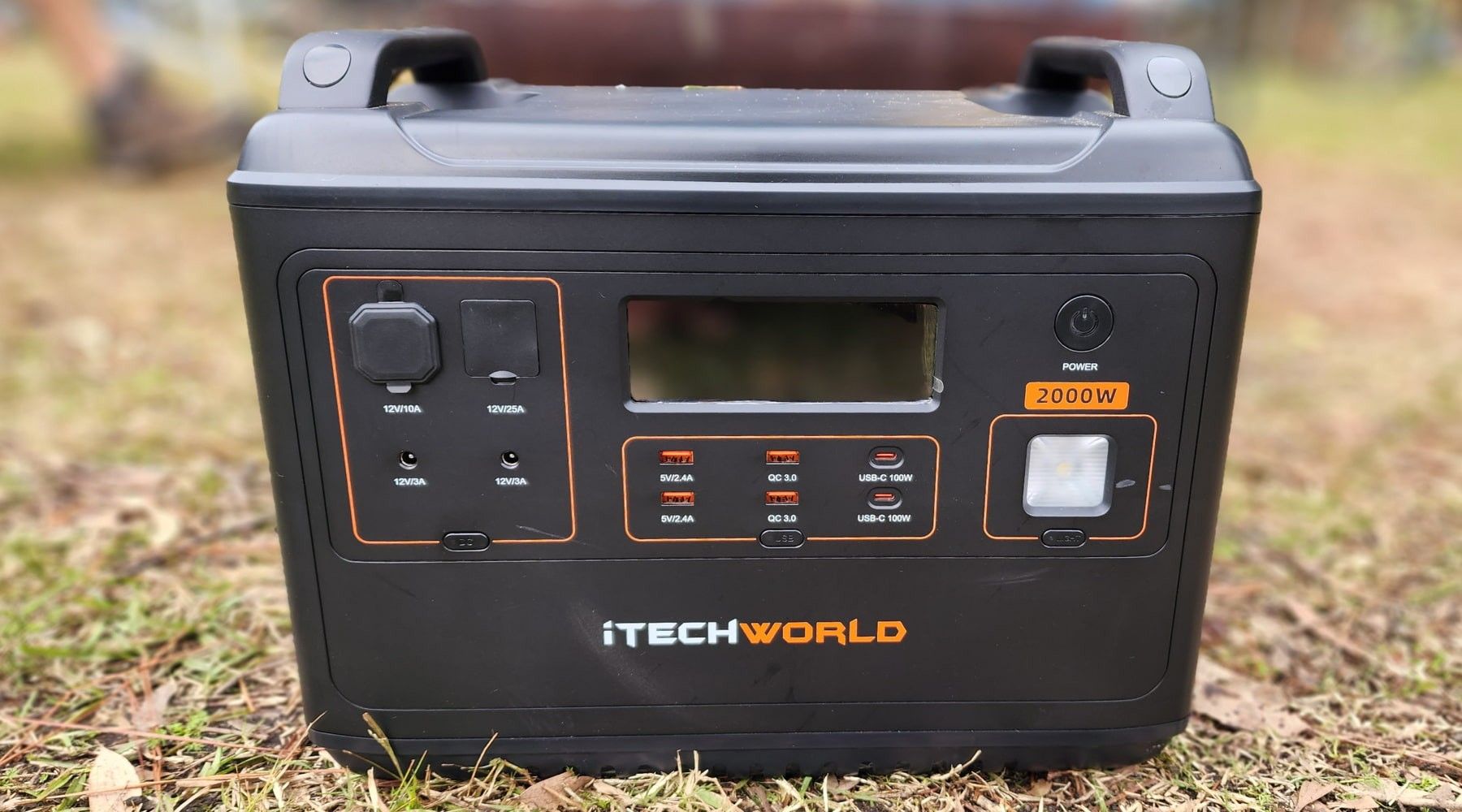
You can take your pick from the iTechworld range of power stations in truth. Built right here in Australia, this family-run business out of Perth makes a quality, premium power station across four sizes. There's the 300, 500, 1300 and 2000, with the number representing the max watt output the device can handle..
In my experiences using iTechworld power stations, they tend to punch above their weight, too. Delivering an efficiency, both with input and output, that makes the most of every one of its watt hours. They are relatively lighter, too, than their competitors.
The best in the range is the 1997 watt-hour, PS2000. This beast will get you through most of your troubles, especially anything like a camping trip off-grid for a few days. It doesn't have my preferred flat top, but the robust handles and straight-edged chassis do make it easy to carry and pack.
Notable features include 2 x 100W USB-C ports, a fantastic 3500 lifecycles (to 80%) longevity, a quick-charge to 80% in 60-minutes, 3 AC ports, a range of 12V ports and an external light. It's driven by the safer LiFePO4 lithium ion cell technology, too.
For the premium power station range that hover around the 2000 watt-hour mark, it's well-priced, too. And it's that and its Australian made roots that give me the inclination to call it the best power station in Australia.
Although, given it's a local company, I am disappointed by the relatively low 2-year warranty.

The newly released Anker 767 Powerhouse ticks just about every box, building on the premium offerings already on the market and then giving it that extra 10%.
There's no doubt it sets you back a pretty penny, retailing for $3799 in Australia. But you're getting a lot here for your moolah. The construction quality is excellent, and the device is smartly designed. The built-in telescopic handle and ruggard wheels make light weight of what on paper looks like a heavy device at 30kg. While the flat top makes it easy to stack and pack.
You can expect a whopping 2048 watt-hours of power, and I've run a typical camping set-up off it for 48-hours with ease. It quick-charges to 80% off mains power in an impressive 60-minutes, too. It's the safer LiFePO4 cell chemistry, which is a must in this writer's opinion, while the whole system is supported by a class-leading 5-year warranty.
What makes this power station particularly good for premium power station seekers - in particular those striving for off-grid living - is the maximum solar energy input. You can put 1000W of solar power into this station, giving you security in knowing you can make the most of sunlight hours to keep your electricity rolling. You can daisy-chain units together, too.
Other critical specs of note include the 2400W max power output, allowing it to run a lot of devices at once. The 3200W surge capability is handy. And managing to reach 3000 lifecycles before dipping below 80% capacity. I would have liked to have seen a 4th AC port, but 3 USB-C 100W outlets is fantastic.
Anker is an Australian company as well, which is also worthy of note.

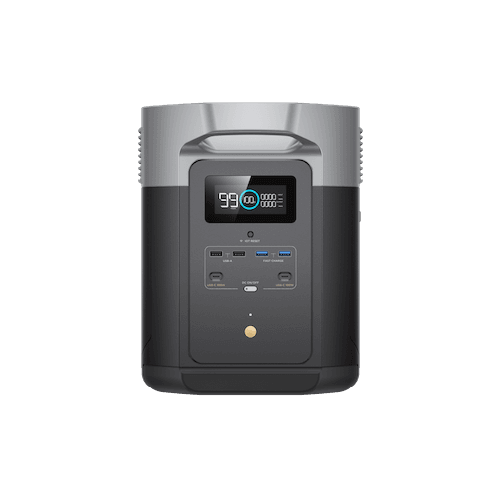
If money isn't an object, you simply cannot go wrong with the EcoFlow Delta Max 2000. This power station is a beast and perhaps overkill for general purpose use like camping. (Although I did love taking it camping!) This really shines when it's an alternate power source for farmers or homes where power outages are common. Especially as they can be daisy-chained together.
A lot of that comes down to raw power. Its 4 x AC ports can each deliver a whopping 3000W power, which can run just about anything. It can surge to 4600W, too - enough to jumpstart your car. With 2016 watt hours of capacity, it lasts a while, too. But you can always plug in up to 800W of solar panels to bring it back to life.
As well as the AC ports, you've got 2 x USB-A fast charge and 2 x USB-A standard ports. There's 2 x USB-C 100W ports and 2 x DC ports. There's wifi and app support, and I'm a fan of the flat top design, as it's easy to store and leave devices on top while charging. I have even sat a projector on it sometimes while camping.
It's definitely heavy, and at 22kg it wasn't the easiest device to move around to be sure. It's also a shame it's a lithium-ion battery, which is not only a little less safe than LiFePO4 cell chemistry, but has reduced longevity. Expect 800 lifecycles to 80% capacity.


NRG Vault is an Australian-owned company, with a long history working with power banks through its better known partner-brand, Laser. This is a LiFePO4, mid-range portable power station, delivering 1288Wh of capacity.
It's a well made battery that can safely handle the rigors of "going bush." But there's plenty of other reasons why I've selected it as your best power station for camping.
While it doesn't quite have the capacity of the bigger premium power stations, you're still getting a lot of watt hours at a much more respectable price point of $1500. You're also looking at a smaller footprint and a slimmer 15.8kg frame, which is easier to get in and out of cars and tents.
Despite this, it doesn't compromise on high-end features. The 2500 lifecycles is more than acceptable, you're still getting 4 AC ports and 2 x 100W USB-C ports. There's a 3 year warranty, too. And it can take 300W of solar input, which is about the max you want to lug around camping..
As its name suggests, the 1500W max power output is more than enough for anything you're likely to take camping. Depending on the weather, you should be able to get 2-days out of your camping fridge, for example. But you can "cheat" and use a jaffle iron or microwave, too.,
Perhaps its most annoying fault is in its design, with a fixed top handle that impacts your ability to place things on top to charge (like a laptop) as well as pack into a vehicle.


EcoFlow is undoubtedly one of the leaders in the power station space and the River Max is a genuine go-getter. At $1099 here in Australia, it's a little on the pricey side, but its superior build quality will last the distance.
Indeed, this LiFePO4 battery is backed in by a 5-year warranty, and claims 3000 lifecycles to 80% capacity.
You get a solid 512Wh lifespan, which charges to 100% in just an hour. That's going to give you no problems with any day trip or overnighter when it comes to powering general consumer technology or even a portable fridge.
It can output up to 500W in normal mode, but can be boosted to 1000W if you suddenly need to run something serious. That said, it won't last too long if you're drawing that kind of power.
The smart design keeps a nice flat surface, and it's got modern trimmings including a 100W USB-C port and an app. We also love that the whole battery only weighs a tickle over 6kg, meaning it's ultra portable.
It gets extra points for not just being receptive to 220W of solar, but the fact you can even charge it via USB-C. Albeit, that takes a bit of time.
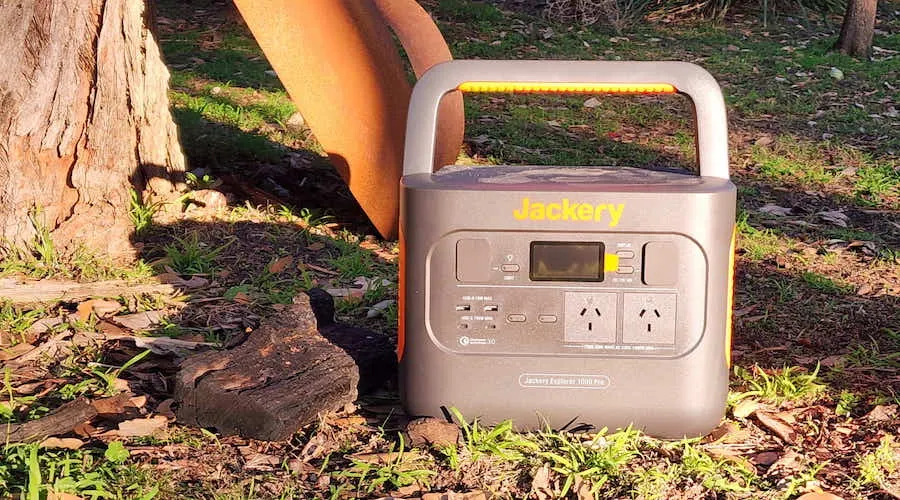
There's pros and cons between using lithium ion power stations, which were the old norm, and the newer LiFePO4 batteries. But for most the safety benefits and longevity of the LiFePO4 outweigh the cons, and most manufacturers are moving that way. But if you really want the extra capacity and power that lithium ion can deliver, there's still options on the market.
Until recently, Jackery wasn't available in Australia, despite being a major player in overseas markets. Namely the USA. It's now landed in Australia, and it's a pretty smart system.
The Jackery Explorer 1000 Pro offers 1002Wh of capacity, with 1000W max output capable of surging to 2000W if required. There's only the 2 x AC ports, but you do get 2 x USB-C 100W ports. It can receive a generous amount of solar, too, at 800W, but is a little bit slow to charge at almost 2-hours via a powerpoint.
It's quite light for its capacity at only 11.5kg, despite having some girth to it. I like the fold down handle, which is countersunk into the top surface for storage and packing. At the time of writing, a free 2-year extension to the warranty brings it up to an impressive 5-years, too, gifting added security.
You do only get 1000 lifecycles, however, until it dips below 80% capacity. And frustratingly, it has a bespoke solar panel DC input design that means you're more-or-less stuck with using Jackery solar panels. As a result, in my opinion, there's better bang for buck to be had with LiFePO4 batteries on this list.
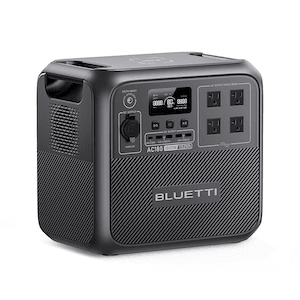
For Australians who rely on a continuous positive airway pressure (CPAP) machine while they sleep, power stations while away from home are vitally important. You want to overshoot a little when determining power needs so you can be sure you won't run out of power in the middle of the night. And ideally, you want to easily be able to charge it up for those multi-day trips.
Unfortunately, most cheaper power stations don't quite have the watt hours to safely ensure a full night's sleep. Nor do they have an AC port that most CPAP machines require to run.
You're looking at the mid-tier range then, and one of the best batteries that will deliver what you need, as well as the flexibility for plenty more, is the Bluetti AC180.
It's a wonderfully built machine, backed by a 5-year warranty and LiFePO4 cell chemistry that will give you 3500 lifecycles to 80% capacity. That capacity is 1152 watt-hours, running at 32V. It can take up to a 1440W appliance as well, and will handle a 2700W surge.
In terms of ports, you've got 2 x AC, as well as 1 x USB-C 100W and 4 x USB-A, to go with a 12V ciggie plug. As an added bonus, there's a wireless charging pad on top.
What's particularly handy here for people looking at multi-day trips, is that Bluetti AC180 is very fast charging (80% in just 45-minutes), and can accept 500W of solar power.
We do wish it was smaller, weighing in at 16 kg. But it's relatively quiet, and doesn't overstate its footprint. So you can sneak it into a small room, caravan or tent to run your CPAP machine.
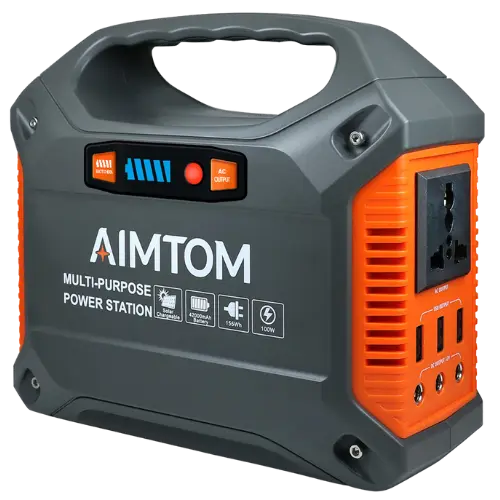
If you're on a budget and just want a power solution for running your work equipment or charging basic tech while on the road,, the AIMTOM PowerPal X is your best bet. Despite going for around the $200 mark, you get quite a lot for your money.
As well as mains power, it also has a built-in MPPT controller for easy solar charging. There are 3 x DC outputs and 3 x quick charge USB outputs. It has a front-mounted LED light and is only 1.6kg with a very small footprint.
Importantly it has an AC output that is very handy at this price range, especially for plugging in a laptop. Although you'll need a US to AU adaptor to plug in local devices.
Given the above, the AIMTOM PowerPal X is suited to short trips away from power when you're not asking it to run any complicated devices. Anything that requires more than 100 watts of continuous power will struggle.
You get what you pay for. Despite its 42Ah capability, you only get 155 watt-hours, which isn't a heck of a lot of juice. And it takes a bit of time to get there. Expect around 8 hours via DC charging via your car's cigarette lighter. The 500 life cycles are also on the low end. But with near-unanimous positive reviews on Amazon, it's clear you still get good bang for your buck.
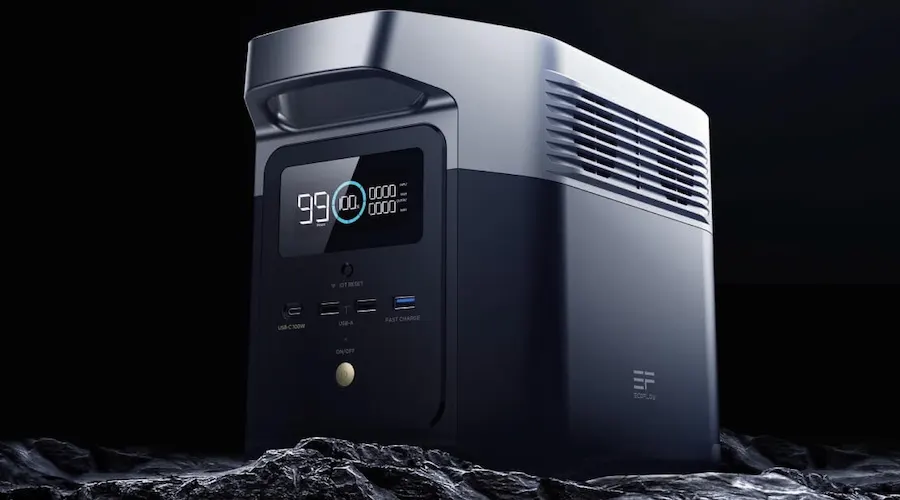
There's no doubt that the activity I most use my portable power stations for, is keeping beer and meat cold. Especially on longer camping trips when it's not easy to resupply with ice constantly.
I can tell you from many years of experience, when it comes to the best power station for portable fridges, you want enough watt hours to get you through a warm summer evening easily. You also want good solar support so you can give it a charge pump easily during the day. And it needs to be light enough that you can move it about easily to keep it in the shade.
The EcoFlow Delta Mini does all that at a reasonable price point. Firstly, EcoFlow is a premium power station brand, with a build quality and reputation to match. The EcoFlow Delta Min is only 10.7kg, which is good given it still offers 882 watt-hours and a maximum 1400W output.
It's solar ready, and can take 300W of input directly into the power station. In addition, it's fast-charging when at home, All done in around 90-minutes.
It's not too shabby on the ports, either. You get 2 x AC ports, 2 x 3A DC ports and 1 x car DC port, 3 x USB-A ports (1 of which is fast charge) and 1 x USB-C (100W) port. Plus it's Wi-Fi and app enabled.
Sadly, it's a lithium-ion battery. Which means it's not quite as safe as some of the other options in the market if not treated correctly. Plus, it's only got 800 lifecycles to 80% capacity.
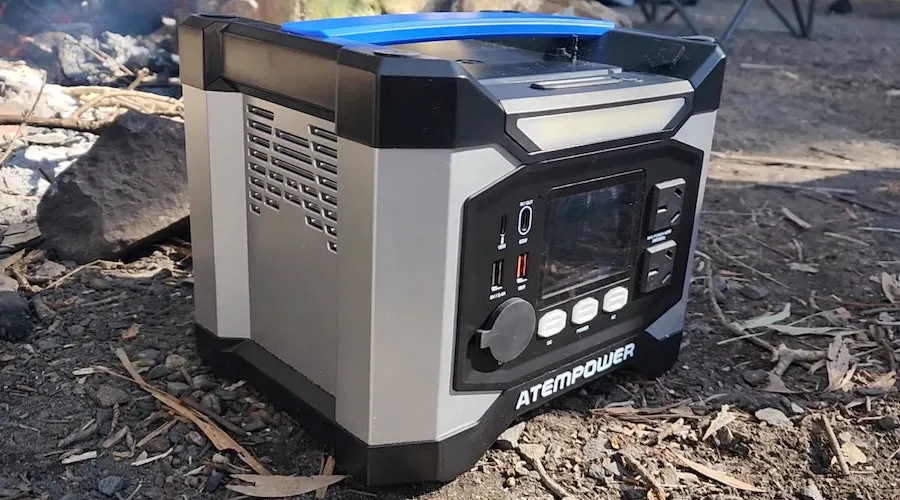
If you're going to live the van life, there's nowhere better than Australia. In my opinion, the best portable power station for van life aficionados is the ATEM Power AP500X.
I was immediately impressed by its lightweight (5.58kg) chassis, small footprint and portable design. This is easy to stowaway, but also a cinch to pull out and have by the picnic table or on the rug as you're soaking up a sunset or chilling by the beach.
It's also great to see its array of ports, which includes 2 x AC ports, as well as 3 x USB-C 60W ports alongside your classic 12V and USB-A options. With 512 watt hours, and a 500W maximum output, it's perfect for charging cameras, phones, laptops, portable speakers and the like, but can also run a bar fridge or simple appliance, too.
It's 100W MPPT solar panel ready. So between that and the DC charging through a cig lighter, you can easily bump up the charge while on the road.
Where it falls down is with its reliance on tempremetal lithium-ion battery cell chemistry, even if it has some protection triggers in place. And also its 300 lifecycles to 80% capacity longevity. Which is effectively saying this isn't your forever and for everything battery… just your van life power station.

The alternative to getting a power station is to grab a battery box. So, what's the difference between a power station and a battery box? Well, a battery box doesn't come with a battery; it's literally a box. You then buy a deep cycle battery – such as one you might purchase for a car, boat or trailer – and place that in the box.
So, why do you need the battery box? The Giantz Chieftain Battery Box not only protects it from the elements, but it also connects the internal battery to an array of ports. There are 2 Anderson plugs, which can be used to output power or input power via solar panels. You also get a 12V DC port and 2 USB-A ports – 1 of these being fast charging. There's even a little LED screen that provides a small amount of information.
You can pick up the box for around the $75 mark and then you can of course make your choice in battery. It's not as easily portable and is a bit more unwieldy than a power station and it doesn't feel as safe, but it works well, is reviewed favourably by customers and will give you power on the go while camping.
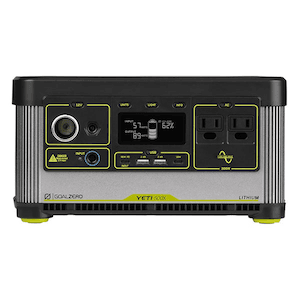
The ports are a little on the dated side, but there is no shortage of options. An AC port at this size and weight is great. There's 2 x USB-A and 3 x USB-C (2 x 18W and 60W sadly), as well as 2 x DC ports, including a car charger.
Charging times aren't great, however. Although being able to charge via both solar and USB-C is welcomed. Especially the latter when you're thinking about compact footprints.
There is compromise for this compact nature, however. It's pretty expensive for a device only offering 505Wh. The lithium-ion cell chemistry is also a pain point, being it impacts longevity (800 lifecycles to 80% capacity) and isn't the safest variant. The 1-year warranty isn't mind-blowing either.
It's worth noting that this is device for charging simple devices and appliances, with a 300W max output, capable of surging to 1200W. It's not going to run a microwave for example. But Yeti is reputable brand, so if you are looking for something compact it's still worth considering.
 Bluetti
Bluetti
38% off BLUETTI Elite 200 V2 Portable Power Station
Power up your adventures with 38% off the BLUETTI Elite 200 V2 Portable Power Station, delivering 2600W and 2073.6Wh of reliable energy. Perfect for home backup or outdoor use, it keeps your devices running smoothly wherever you are.
 The Good Guys
The Good Guys
Portable power stations starting at $399
Get the power you need, where you need it, with a portable power station, starting from just $649 at The Good Guys. T&Cs apply.
 Amazon
Amazon
Portable power stations starting at $149.99
Get a portable power station at Amazon starting from just $149.99. T&Cs apply.
 eBay Australia
eBay Australia
$100 off Jackery Explorer 1000 Pro Power Station
Get it now for only $1,899, down from $1,999 at eBay. T&Cs apply.
 eBay Australia
eBay Australia
$150 off Goal Zero Yeti 500X Lithium 230V portable power station
Get it now for only $1,249.95, down from $1,399.95 at eBay. T&Cs apply.
 eBay Australia
eBay Australia
Up to 52% off portable power stations
Enjoy huge savings on portable power stations at eBay. T&Cs apply.
 Kogan
Kogan
Portable power station from $531.95
Never run out of power again with portable power station starting at just $531.95 at Kogan. T&Cs apply.
 Temu
Temu
Up to 70% off portable power stations
Power your devices anywhere, anytime with a portable power station with savings of up to 70% at Temu. T&Cs apply.
 Myer
Myer
Portable power station from $498
Stay powered up on the go with a portable power station with prices starting at just $498 at Myer. T&Cs apply.
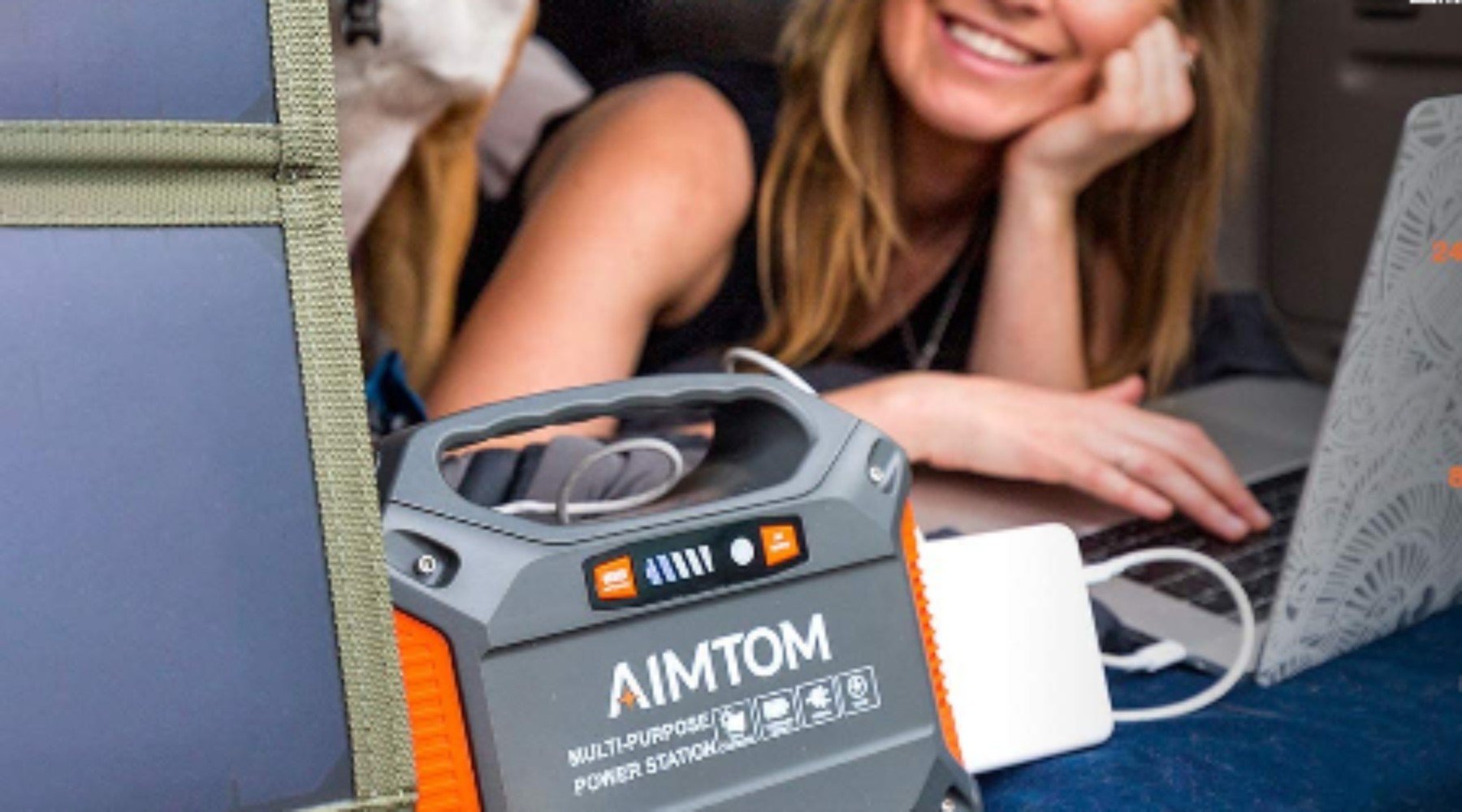
There are a few key things to think about when choosing a power station. The most important, however, is to understand your power needs. What are you going to be doing with your power station? Think about the products you are connecting to the power station and find out their amp consumption or wattage draw. Then work out how many of these products you will want to use at the same time. And from there you can begin to calculate your likely consumption.
For many of you, a likely scenario is running a fridge at around 60W. If you run it for 12 hours without charge – say overnight – that will consume 780 watt-hours. Maybe charge a phone for a couple of hours at 11W as well, so that might be another 40 watt hours. Run some LED light stips at 24 watts for 6 hours and that's 144 watt-hours. You get the idea.
This gives you an idea of your general consumption. And in the above scenario, anything less than 1000 watt-hours may not get you through a 24-hour period without some love from a few solar panels.
But you also need to think about the required power a device needs to even run. A microwave might need 1100W of power just to work! So you need to make sure that the AC ports on your power station can output at least that amount of consistent power if that's your use case.
Other devices may need a surge of power to get going, before they cool off to need fewer continuous watts of power to keep running. For example, power tools. So make sure you don't under-spec your power station for your needs.
We looked at power stations from the following brands and eliminated any products with poor customer feedback, low availability in Australia or brands yet to establish their reputation:
Our editorial team selected the best power stations on the above list based on a number of factors. This includes the average customer rating at established ecommerce sites like Amazon and eBay (as of April 2021). We also looked at industry-specific sites like Anaconda, BCF, Tentworld and Snowys.
We carefully collected data from each review to identify recurring pros and cons for each product based on category-specific criteria such as speed, durability, size and price. Review volume and quality were also factored into our shortlist. Where multiple products had similar review scores, price was used as a deciding factor. We corroborated our choices with other professional review sites to identify any anomalies.
Finally, we brought our own personal experiences testing these products into the decision.
If you're looking to buy a new power station for the first time, getting your mind around what the specifications mean can be a challenge. Here are the key specs you need to think about. These are also the specs that most contribute to the asking price.
Watt hours: This is going to give you a general indication of how long your power station will last. The more watt-hours, (often referred to as Wh), the longer it will run the same appliance before going flat.
Watt hours vs amp hours: Sometimes you will see amp hours (Ah) used instead of watt hours. Technically there is an easy conversion that can be made, as watt hours = volts x amp hours. In Australia, we assume volts will be roughly 12.4 if not listed. But batteries can operate at higher voltages depending on the cell chemistry, so make sure you check the specs before you do the conversion.
Max AC Output: This is generally the figure you'll find in the nomenclature of a power station. So if you see a 1000 in the title, it most often means 1000W max output, not 1000 watt hours. The max output reveals how many things you can have plugged in drawing at once before the power station freaks out and shuts down. Different products need different power inputs. A microwave, for example, generally needs 1100W. So a power-station at 1000W max output, won't run it.
Max Solar Input: If you're intending to pair your power station up with some solar panels, this figure is important to note. It reveals the maximum amount of solar input the power station can leverage for charging. If you have a power station with a 200W maximum solar input, and plug 400W of solar panels into it, you're at risk of over-charging and damaging the battery.
USB-C: Many of us now charge our devices through USB-C, so ports of this modern ilk are definitely desired. But not all USB-C ports are the same. The higher the watt of the USB-C port, the quicker it can charge. Most modern power stations will have at least 100W USB-C ports.
Lifecycles: Each time you charge a battery, drain it, charge it, drain it and so forth, its overall capacity degrades. As a result, over time it will hold less charge. The general practice is to reference how many times you can charge and drain a battery before its capacity dips below 80% of its advertised maximum. These are referred to as lifecycles. The more lifecycles, the longer the battery will give you the desired charge.
Cell Chemistry (LiFePO4 vs Lithium-ion): This is a critical one for anyone worried about the risk of battery-related fires. The safest option is a LiFePO4 battery, which stands for lithium iron phosphate battery. As opposed to a lithium-ion battery, also known as NMC (Nickel Manganese Cobalt). If you want to get technical, it comes down to the stronger covalent bonds between the phosphorous, oxygen and iron atoms in LiFePO4. They reduce the chemical thermal runway that can result in a fire.
Weight: Make no mistake, power stations are heavy. And generally, their weight is directly proportional to their might. You have to not just think about your use case here, but also your personal strength. To a certain extent design can help. A good handle, or even wheels, can help with portability.



These are the 10 best massage guns available right now in Australia.
These are the 6 best telescopes you can get right now in Australia.
From the best option with heat to the top machine for pregnancy, these are the 12 best foot massagers available online.
We’ve rounded up the 10 best portable solar panels you can get right now in Australia.
We've chosen the best electric scooters in Australia to get you from A to B quickly and easily.
These are the 10 best binoculars you can get right now in Australia.
From the best electric bike to the top bicycle for the beach, these are the 12 best bikes you can buy online.
These are the 14 best treadmills you can get right now in Australia.
Choosing the best gym for you can be hard when there is much choice. Here is the ultimate gym comparison table along with our top tips to help you make your decision.